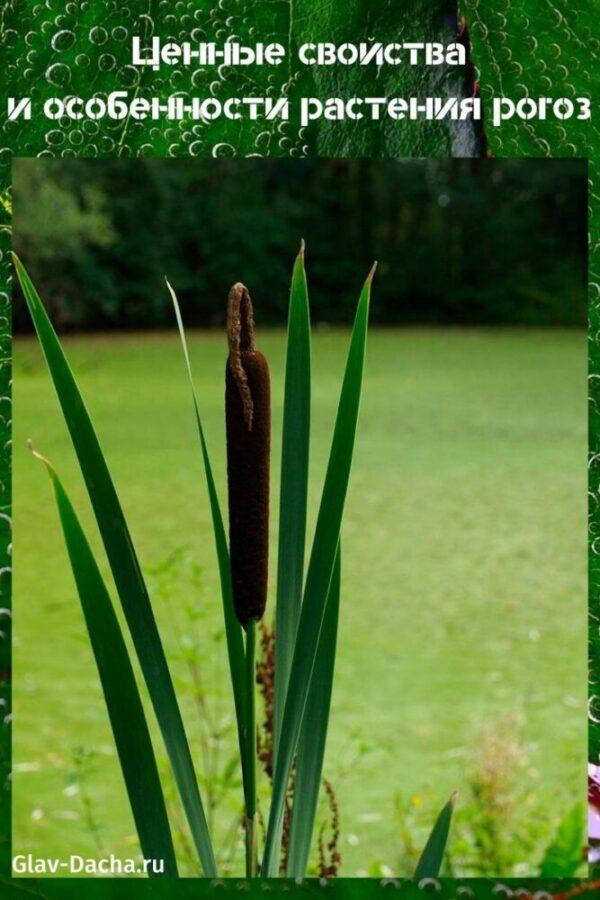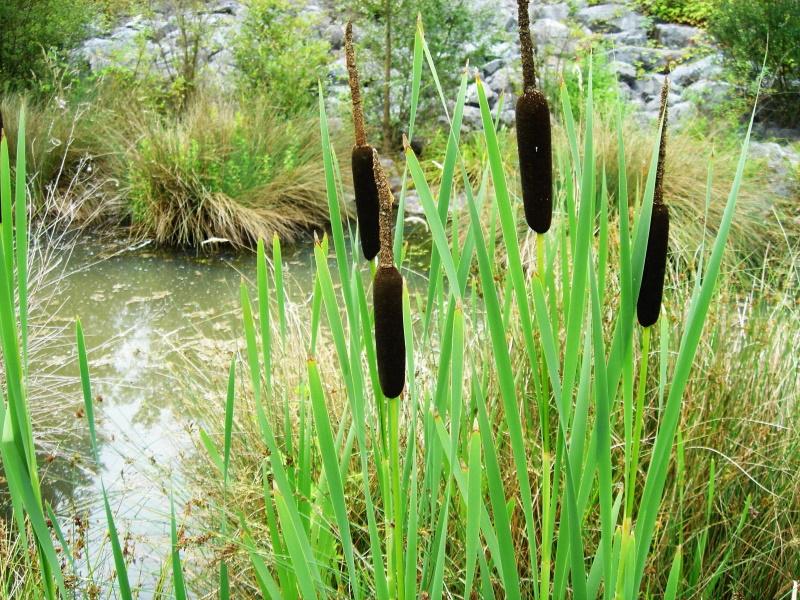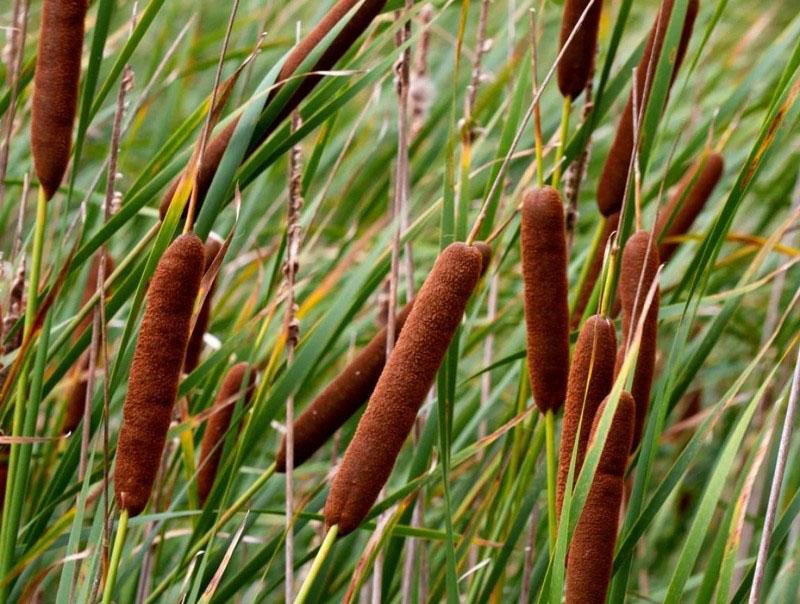Valuable properties and features of the cattail plant
 The cattail plant is a well-known marsh grass that can be found everywhere, even in the tundra and subtropics. In the genus of cattails, there are 37 species, 30 of which are primary, and 7 are hybridogenic. The plant has very long, two-row leaves, similar to ribbons and small flowers, collected on one peduncle in male and female inflorescences. Moreover, female pistils form dense fluffy cobs. Cattail blooms from June to August.
The cattail plant is a well-known marsh grass that can be found everywhere, even in the tundra and subtropics. In the genus of cattails, there are 37 species, 30 of which are primary, and 7 are hybridogenic. The plant has very long, two-row leaves, similar to ribbons and small flowers, collected on one peduncle in male and female inflorescences. Moreover, female pistils form dense fluffy cobs. Cattail blooms from June to August.
Cattails (Typha) should not be confused with reeds (Scirpus). Although they look similar at first glance, the reed belongs to the sedge family, it is a different plant.
Where does cattail usually grow?

 Most of all cattails in the south of Eurasia and North America. Different species require areas with rich acidic or saline soils, which should be well lit by the sun during the day. During the growing season, due to powerful rhizomes, cattails form dense thickets. Despite the fact that plants do not respond to fluctuations in the water level in reservoirs, reproduction occurs best if the depth indicator corresponds to 60–90 cm.
Most of all cattails in the south of Eurasia and North America. Different species require areas with rich acidic or saline soils, which should be well lit by the sun during the day. During the growing season, due to powerful rhizomes, cattails form dense thickets. Despite the fact that plants do not respond to fluctuations in the water level in reservoirs, reproduction occurs best if the depth indicator corresponds to 60–90 cm.
 Cattail is propagated, if necessary, by dividing the roots. This is the simplest and most successful method of creating an entire colony of plants that will protect neighboring plants, such as water lilies, from strong winds. In addition, cattails are natural filters. And their planting is a natural treatment plant!
Cattail is propagated, if necessary, by dividing the roots. This is the simplest and most successful method of creating an entire colony of plants that will protect neighboring plants, such as water lilies, from strong winds. In addition, cattails are natural filters. And their planting is a natural treatment plant!
Cattail plant: species for decorating plots
 Among all cattails, several main species can be distinguished that grow in different regions of the planet. Usually these are typical coastal aquatic plants, preferring silty and silty-sandy shores, protected from waves. On stony soils, low, sparse communities are most often found.
Among all cattails, several main species can be distinguished that grow in different regions of the planet. Usually these are typical coastal aquatic plants, preferring silty and silty-sandy shores, protected from waves. On stony soils, low, sparse communities are most often found.
Cattail is a plant of water bodies, therefore it is used to decorate garden landscapes near streams and artificial waterfalls.
Suitable for these purposes:
- Narrow-leaved cattail is a plant with oblong-linear leaves, collected at the base of the stem, less than 1 cm wide. It needs nutritious clay soil. It does not always cob in cool summer. In addition to the Northern Hemisphere, it grows in southern Africa and Australia.

- Cattail broadleaf - common in the Northern Hemisphere. It differs from other species in thicker and higher stems. The diameter of the inflorescence velvety to the touch is about 2.5 cm. Brown cobs are very decorative, and only in the spring they begin to disintegrate into separate seeds. It grows on acidic, waterlogged soils.

- Laxman's Cattail - Prefers well-watered areas near rivers and lakes. Found in the steppe zone and subtropics. There is a lot of it in the Caucasus, the Far East, Siberia, Mongolia and China. The average height of plants is from 60 to 90 cm, the maximum is 130 cm. The leaves are gray-green, narrow. The ears are brown.

- Small cattail - grows in the marshy areas of Western Europe, as well as in Central Asia, China, Mongolia, Turkey, found in the Caucasus.It is a short and very graceful plant with thin leaves. The pistillate part of the inflorescence is brown, expanding towards the apex.

Also in demand for landscaping bog areas of small private ponds small cattail, the height of which is only 30-60 cm and graceful cattail. These compact plants look great in winter, are incredibly beautiful in bouquets and ekibans, but they cannot withstand severe frosts. In the fall, they are placed in containers and transferred to a cold basement.
In good conditions, the cattail behaves aggressively - it is able to capture a large territory in a short time. Therefore, it is better to plant several plants on the site in containers or in bags from a geogrid.
Useful properties of cattail
 The most common in the CIS countries are broadleaf cattail and narrow-leaved cattail. Both species have properties that are important for humans. There are many useful substances in their chemical composition.
The most common in the CIS countries are broadleaf cattail and narrow-leaved cattail. Both species have properties that are important for humans. There are many useful substances in their chemical composition.
The use of cattail in traditional medicine
 All parts of the cattail plant are considered valuable - flowers and cobs, rhizomes, stems, leaves, everything is used. Cattail is a natural antiseptic, has a bactericidal and hemostatic effect, promotes wound healing. The rhizomes of the plant contain tannins and various sugars, calcium oxalate, starch. The leaves contain ascorbic acid, the seeds contain fatty oil, and the flowers contain glycosides.
All parts of the cattail plant are considered valuable - flowers and cobs, rhizomes, stems, leaves, everything is used. Cattail is a natural antiseptic, has a bactericidal and hemostatic effect, promotes wound healing. The rhizomes of the plant contain tannins and various sugars, calcium oxalate, starch. The leaves contain ascorbic acid, the seeds contain fatty oil, and the flowers contain glycosides.
 The use of an aqueous extract of leaves and rhizomes improves the condition of the body with cystitis and enterocolitis, dysentery. The ears are boiled for bronchial asthma, and the leaf infusion makes life easier for some people with type 2 diabetes. Down mixed with ghee or lard is used as an external remedy for frostbite and burns.
The use of an aqueous extract of leaves and rhizomes improves the condition of the body with cystitis and enterocolitis, dysentery. The ears are boiled for bronchial asthma, and the leaf infusion makes life easier for some people with type 2 diabetes. Down mixed with ghee or lard is used as an external remedy for frostbite and burns.
Before deciding on the use of infusions and funds made independently on the basis of the cattail plant, you should consult your doctor in order to exclude a possible allergic reaction. And only after the recommendations received from him, you can start treatment.
Economic value of cattail
 For a long time, man drew attention to the unique properties of the plant.
For a long time, man drew attention to the unique properties of the plant.
Even now, packaging materials and various objects are made from its leaves and stems, or they are used for other purposes:
- weave mats and baskets;

- build various temporary shelters, huts;
- down, extracted from brown cobs, stuff pillows, blankets, mattresses, life belts;
- to obtain a soft felt from which hats are made, in handicraft workshops, cattail fluff, in a certain proportion, is mixed with wool.
Cellulose is obtained from the bracts of cattail plants, they are also added to clay or chamotte so that there is no shrinkage in the manufacture of ceramic products, and low-grade paper is made from all parts of the plant. But that's not all. In field conditions, the ears can be used to light a fire or instead of a torch, if they are well saturated with oil beforehand. 
Cattail leaves contain protein (about 16%), fiber (about 36%) and calcium. Therefore, feed for farm animals is obtained from it by ensiling.
Using plant parts for food
 The plant has edible rhizomes, stems and leaves. Young white rhizomes are eaten even raw, if they are sure, of course, that they are clean enough. But the roots of cattail plants can be yellow, which means that they are already old, it is better to fry them like potatoes. Young shoots are boiled in salted water and used in salads or pickled. Their taste is somewhat reminiscent asparagus.
The plant has edible rhizomes, stems and leaves. Young white rhizomes are eaten even raw, if they are sure, of course, that they are clean enough. But the roots of cattail plants can be yellow, which means that they are already old, it is better to fry them like potatoes. Young shoots are boiled in salted water and used in salads or pickled. Their taste is somewhat reminiscent asparagus.
 People learned how to make meal from the roots of cattail about 30,000 years ago. They contain 15% starch and are considered quite nutritious. Nowadays, tasty and healthy jelly is prepared from such flour. They also add it to wheat or rye flour and bake fluffy buns and pies.Chopped, dried and roasted cattail roots are used to prepare a coffee drink.
People learned how to make meal from the roots of cattail about 30,000 years ago. They contain 15% starch and are considered quite nutritious. Nowadays, tasty and healthy jelly is prepared from such flour. They also add it to wheat or rye flour and bake fluffy buns and pies.Chopped, dried and roasted cattail roots are used to prepare a coffee drink.
For the first time, you need to eat cattail and products prepared from it carefully and in small quantities.